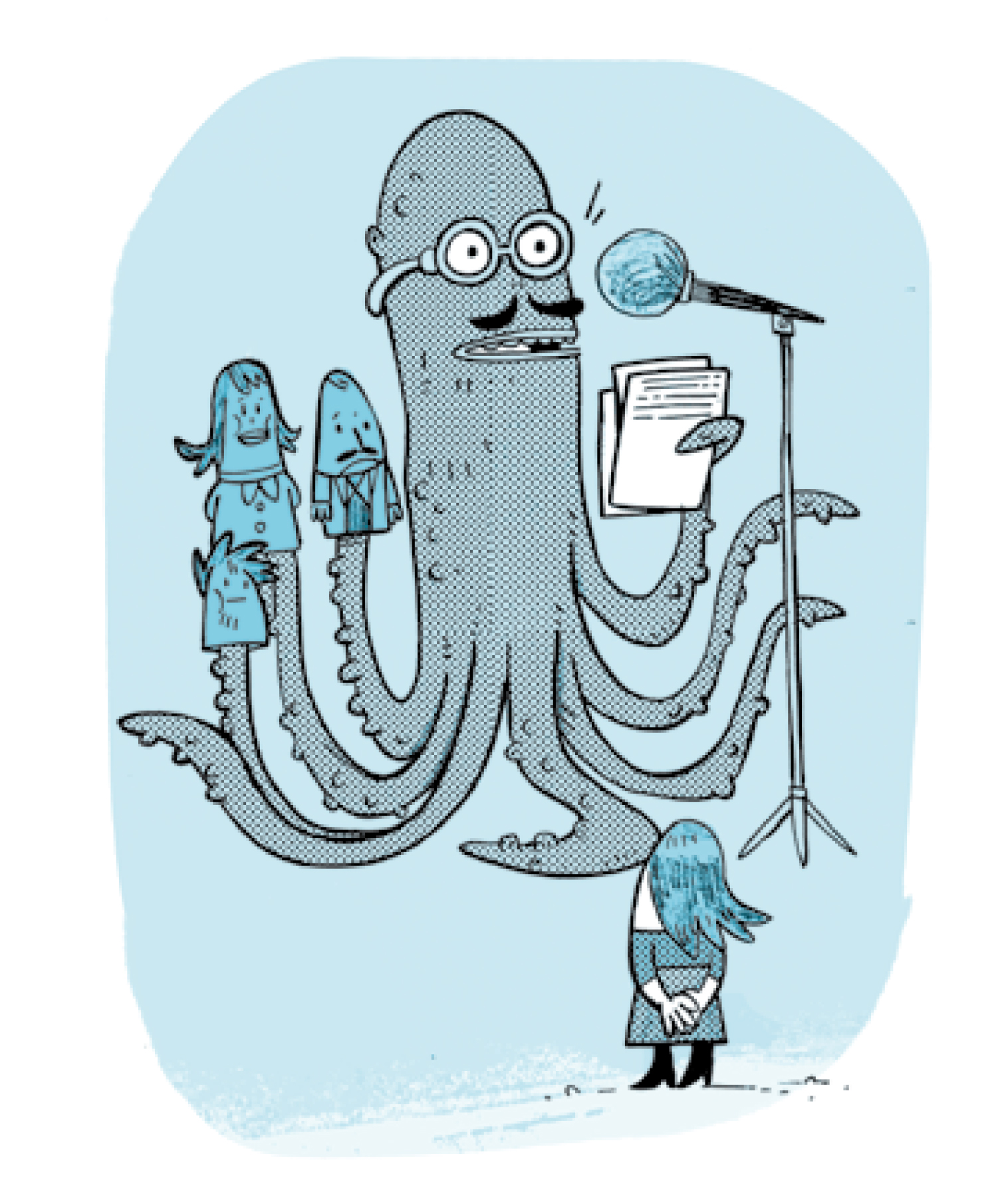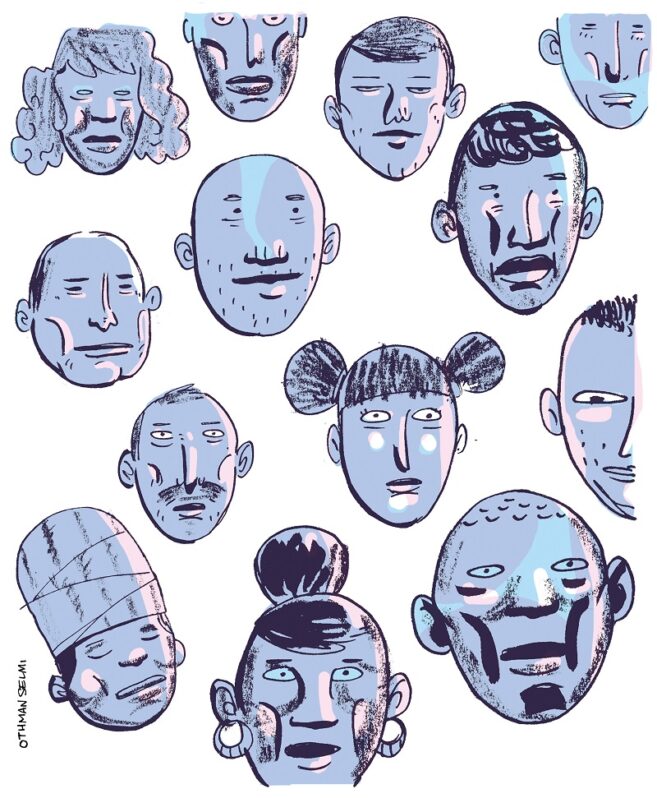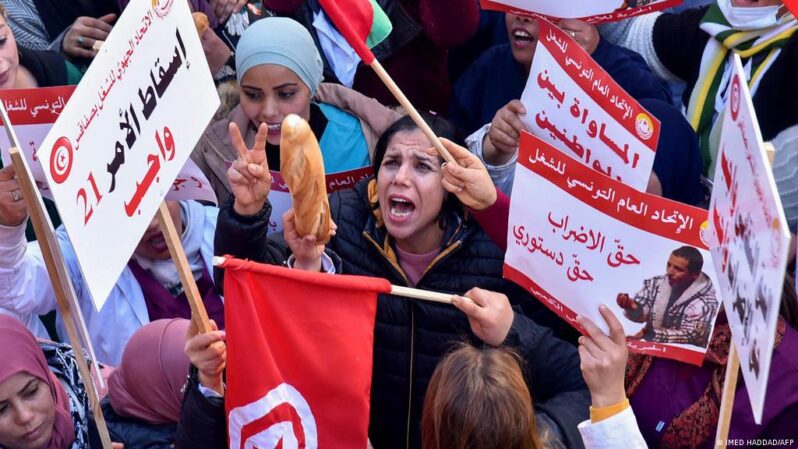The Law to Eliminate Violence Against Women in Tunisia: Civil Society Struggles Pay Off

On July 26, 2017, the Tunisian Parliament approved the Organic Law on Eliminating Violence Against Women. This law is the culmination of the struggle that civil society organizations have waged since their establishment, particularly the Association of Democratic Women of Tunisia (ATFD), which opened a center in 1993 to aid and receive female victims of violence and support them in filing court cases.
This new law is a key step in protecting battered women and criminalizing those who perpetrate violence against them. It establishes new mechanisms to care for them. This article will explore how civil society organizations achieved this victory, what the benefits of this law are, and how the draft evolved to take into account the demands and recommendations of women’s and rights organizations.
The Law on Eliminating Violence Against Women: A Victory for Civil Society
This law is one of the gains made by the organizations of independent civil society that have, since the early 1990s, constantly demanded that the state address violence against women while state bodies refused to discuss it as a social phenomenon. These bodies considered the violence to be restricted to isolated cases foreign to our social values and principles.
Even when ATFD released a poster bearing the slogan “Violence is a Scourge and Silence is Harm”, the Ministry of Interior summoned its members on the basis that the poster undermines the tranquility of the family and of society and does not fall within the scope of NGO work. However, the ATFD insisted on continuing this campaign, altering the slogan so that it pertained only to the private sphere and workplace. Facing the government’s obstinate refusal to uphold its responsibility for combating private violence against women, women’s organizations took it upon themselves to establish spaces for listening to the victims of violence and supporting them legally, psychologically, socially, and politically. The ATFD’s Center for Listening to and Directing Women Victims of Violence was established in 1993.
International NGO work evolved during this period of the early 1990s, particularly after moot trials were held in the 1993 World Conference on Human Rights in Vienna. A new perspective on violence against women developed based on a human rights approach and considered violence against women a violation of these rights. The ATFD held an international meeting on the phenomenon of violence against women that resulted in the publication of a book. This book remained shelved by the Ministry of Interior until 2008, as the authorities continued to ignore violence against women as a social phenomenon.
In 2002, the ATFD submitted an alternative report to the United Nations Committee on the Elimination of Discrimination against Women (CEDAW) after the Tunisian state submitted its official report. The ATFD’s report emphasized two key points, namely violence against women and the Tunisian state’s reservations on the Convention on the Elimination of all Forms of Discrimination Against Women. Consequently, the committee’s members were able to direct observations to the Tunisian government, calling upon it to treat the phenomenon of violence against women seriously and take the appropriate measures to curb it.
In 2004, the ATFD organized a campaign on sexual harassment against women at work and presented a draft law to add articles criminalizing it to the Penal Code. The political authorities rejected the campaign. Instead, the Ministry of Interior organized a campaign to preserve good morals, and the courts ruled on 200 cases of violating good morals during 2004. In the summer of that year, Parliament also amended several articles of the Penal Code’s chapter on good morals in order to criminalize sexual harassment. Although the amendment did not implement all of women’s demands, it constituted a victory for the associations that organized the campaign.
In the same year, Spain issued a law on violence against women. After a meeting on the topic attended by Spanish representatives and experts, the women’s associations – particularly the ATFD – became convinced of the importance of enacting a law on violence against women and demanded that the state develop a strategy to combat it. In 2008, the state, via the National Board for Family and Population, conducted the first national survey on violence against women. The results were published in 2010, the same year in which the ATFD submitted a report to the CEDAW Committee as an alternative to the official report submitted by the Tunisian state. The AFTD’s report included several recommendations for protecting women from violence and issuing a law on the topic.
In 2011, after the revolution and after civil society organizations achieved another victory in the form of the adoption of gender parity in the electoral lists, these organizations ran campaigns for a law on violence against women and to constitutionalize women’s human rights. To this end, while the National Constituent Assembly (NCA) was writing the Constitution, the AFTD organized a mock constituent assembly with many humanitarian and women’s organizations. Several guests from the Arab region, particularly Lebanon, Morocco, and Palestine, were also in attendance. This assembly produced the draft “Constitution of Equality and Citizenship Through Women’s Eyes”.
In 2012, the AFTD organized several campaigns with other organizations for the sake of incorporating various principles into the Constitution: equality between male and female citizens in rights and duties, the protection of women’s acquired rights, gender parity, and the protection of women from violence. The campaigns took various forms. These included meetings with MPs (especially female MPs convinced of the need to improve women’s status) and with representatives of civil society organizations. They also included the issuing of pamphlets and posters, as well as holding protests in front of the NCA’s premises to distribute recommendations to MPs and the media. The campaigns kept pace with the NCA’s work by organizing public actions whenever a new constitution draft was issued. Peaceful rallies were also held in Habib Bourguiba St in Tunis to demand that the NCA back down from several concepts and principles that were enshrined in the first version of the Constitution. One such principle was complementarity, which was replaced with equality amidst pressure from NGOs and democratic movements in the summer of 2012.
All these actions culminated in the issuance of a constitution stating the principles of equality between male and female citizens in rights and duties without discrimination. The Constitution thus called on the state to take the necessary measures to eliminate violence against women.
After the Constitution was issued, the State Secretariat for Women and Family, at the instigation of the United Nations Population Fund, formed a national committee of independent experts in sociology, reproductive health, and various legal fields. In preparing the law, the aforementioned secretariat adopted a participatory approach incorporating the various government bodies and constituents of civil society in the various regions. The committee began its work in March 2014 and presented the draft framework law on August 13, 2014 – the 58th anniversary of the Civil Status Code’s issuance. However, this first draft never saw the light of day because of the abundance of criticism it faced, particularly from religious movements. These movements used television channels, such as Zitouna TV, to attack the draft.
A number of subjective and objective factors prevented the draft from being accepted. The subjective factors included the fact that most of the experts selected are affiliated with the democratic rights movement, particularly the AFTD, which has struggled since its establishment against the reactionary tide and organized many campaigns against discrimination and violence. Some Ennahda Movement politicians consider the organization hostile to religious thought and the hijab, and subsequently refuse to work with it. The objective factors were related to the draft’s comprehensiveness. It addressed most topics related to violence against women, addressed the body of laws that needed to be amended in the public and private sphere in order to curb the violence, and presented the reforms and revisions that needed to be carried out, particularly in the Civil Status Code, the Labor Law, the Civil Service Law, and the Penal Code. This comprehensive approach prompted several political actors to criticize and reject the draft. The choice to take this approach stemmed from the fact that the state had previously only taken a few partial measures to punish some forms of violence against women specifically in the family and vocational setting.
However, after a period of back-and-forth, it was decided again to finish the draft. Two experts were chosen to finalize it. They finished their work in early 2015. However, some of the ministries had reservations about the draft. In particular, the Ministry of Justice felt that the draft could not be accepted until the revision of the country’s penal policy and penal law was completed. Due to pressure from civil society organizations (which contacted the ministers of justice and defense) and international and regional organizations, such as the European Union, the Council of Ministers eventually approved the draft. It was lodged in Parliament in July 2015.
In October 2015, the National Coalition to Eliminate Violence Against Women and Girls (CNAV) was formed under the slogan “a law that truly protects women from violence”. This step followed a conference on violence against women in which more than 60 national and international organizations drew on comparative experiences in countries that had enacted laws to curb the violence. A follow-up committee also formed and developed a strategy for the CNAV’s advocacy.
The CNAV presented an advocacy paper containing the organizations’ recommendations based on analyses prepared by some of them, including the AFTD’s critical analysis of the law. This analysis attempted to rectify the law’s shortcomings and make recommendations to strengthen it.
The CNAV’s presence was felt during the debate of the draft, as it influenced the redrafting of some articles to ensure that women are protected from violence. Now that the law has been issued, the CNAV is preparing to continue its work to ensure the effective application of the law in order for women to take refuge in it when facing mental, physical, sexual, economic, or any other kind of violence.
Benefits of the New Law in Eliminating Violence Against Women
This law contains key benefits for eliminating violence against women that bring it close to international standards. These benefits include the fact that the law aims, as stated in the first article, to “establish measures to eliminate all forms of violence against women based on gender discrimination in order to achieve equality and respect human dignity”. This means that the elimination of violence against women is a guarantee of equality and respect for their human rights.
The law defines the forms of violence, namely sexual violence, moral violence, physical violence, and economic violence. It sets economic violence into the context of economic exploitation, defining it as “every action or inaction that could deprive a woman of economic resources, such as depriving her of money, remuneration, or basic needs; controlling her wages or income; or prohibiting her from working or forcing her to do so”. It defines vulnerability as a situation wherein the woman believes that she is compelled to yield to exploitation and violence. This arises, in particular, from young or advanced age or a case of serious illness, pregnancy, or mental or physical impediment that prevents her from confronting the offender.
The law is based on four common cornerstones underlying the laws that have addressed violence against women. The first cornerstone is violence prevention. This requires a concerted effort by all governmental and non-governmental parties to envisage national policies to disseminate a culture of human rights and change mindsets as well as policies aimed at curbing violence in the sectors of education, higher education, youth, sport, children, women, religious affairs, social affairs, health, and the media. Prevention is also related to the role of civil society organizations and the establishment of mechanisms of partnership, support, and coordination between them and the ministry charged with women’s affairs.
Protection, the second cornerstone, entails legal protection for women victims and children residing with them. They have the right to receive legal guidance on the provisions governing litigation procedures and the services available, legal aid, fair compensation, health and psychological monitoring, appropriate social support, public and associational care, and immediate shelter within the limits of available resources. Protection is also extended to any person – including those bound by professional confidentiality – reporting to the relevant bodies whenever he or she learns of or witnesses violence against a child or woman.
The legislature also amended articles pertaining to sexual harassment. The victim now enjoys greater protection when pursuing a court case and is no longer vulnerable to a defamation case if the judge dismisses the claim, as was previously allowed under Article 226 quarter of the Penal Code.
The law removes a woman’s ability to drop the case. This is intended to stop prosecutions, trials, or the execution of the sentence in favor of the husband when violence is committed. It prevents impunity. The law also abolished the ability of persons who have intercourse with a female minor with her consent to escape punishment by marrying her.
The third cornerstone of the law is the criminalization of the perpetrators of the violence via the revision and replacement of some Penal Code articles and the addition of new ones pertaining to certain crimes. In particular, these articles cover crimes in which the victim is a child or vulnerable woman, crimes perpetrated by an ancestor or descendant of the victim, and crimes in which the perpetrator has authority over the victim or exploits the influence of his job position. The law expands the concept of violence in intimate and family relationships to include not only spouses, but also former spouses, fiancés, and ex-fiancés.
In the section on criminalization, the legislature defined rape as any act leading to sexual penetration, irrespective of its nature, against a female or male without his or her consent. It thereby deemed that rape can be committed against females and males. This was affirmed by Article 227 bis, which pertains to anyone who has sexual contact with a male or female child over the age of 16 and under 18 without the child’s consent. The law thereby raises the age of consent from 13 to 16. In the same article, the legislature also designated incest as one of the crimes of raping a child.
The legislature criminalized the abuse of a woman if it results in disfigurement or partial or total mutilation of her genitals. It also criminalized any kind of repeated verbal or psychological abuse or violence committed by a spouse that could undermine their victim’s dignity and honor or affect her bodily or psychological integrity. The harassment of women in public places with any action, utterance, or gesture that could undermine her dignity or honor or offend her decency was also criminalized.
Additionally, the law punishes whoever discriminates in remuneration for work of equal value on the basis of gender, directly or indirectly employing children as domestic workers, acting as a middleman in the employment of children as domestic workers, and discriminating actions that involve preventing the victim from enjoying her rights, accessing a benefit or service, conducting her activity in an ordinary manner or refusing to employ her, firing her, or penalizing her.
The fourth and final pillar is the procedures, services, and institutions that provide care to women victims of violence. This includes having the Prosecutor of the Republic charge one or more of his assistants with receiving and investigating complaints about violence against women. It also includes allocating, in the first instance courts, separate spaces comprising judges responsible for cases of violence against women on the level of prosecution, investigation, and family disputes.
The law also stipulates the establishment of a unit specialized in investigating crimes of violence against women in every police and national guard station in every one of the 24 governorates. These units must include female personnel and, upon receiving a report of violence against a woman, go immediately to the location and inform her of all her rights, including the right to apply for protection from a family judge. The family judge examines protection applications and may, via a protection order, take a series of measures to protect the woman and children residing with her. These measures include taking them to safe places, taking the victim to hospital to receive first aid if she is injured, and removing the suspect from the residence or preventing the perpetrator from approaching the victim.



